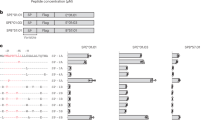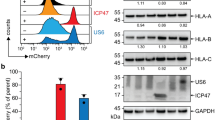Abstract
Classical human leukocyte antigen (HLA) molecules of the major histocompatibility class II (MHCII) complex present peptides for the development, surveillance and activation of CD4+ T cells. The nonclassical MHCII-like protein HLA-DM (DM) catalyzes the exchange and loading of peptides onto MHCII molecules, thereby shaping MHCII immunopeptidomes. Natural variations of DM in both chains of the protein (DMA and DMB) have been hypothesized to impact peptide presentation, but no evidence for altered function has been reported. Here we define the presence of DM allotypes in human populations covered by the 1000 Genomes Project and probe their activity. The functional properties of several allotypes are investigated and show strong enhancement of peptide-induced T cell activation for a particular combination of DMA and DMB. Biochemical evidence suggests a broader pH activity profile for the new variant relative to that of the most commonly expressed DM allotype. Immunopeptidome analysis indicates that the compartmental activity of the new DM heterodimer extends beyond the late endosome and suggests that the natural variation of DM has profound effects on adaptive immunity when antigens bypass the canonical processing pathway.
This is a preview of subscription content, access via your institution
Access options
Subscribe to this journal
Receive 12 digital issues and online access to articles
$119.00 per year
only $9.92 per issue
Buy this article
- Purchase on Springer Link
- Instant access to full article PDF
Prices may be subject to local taxes which are calculated during checkout




Similar content being viewed by others
References
Blum, J. S., Wearsch, P. A. & Cresswell, P. Pathways of antigen processing. Annu. Rev. Immunol. 31, 443–473 (2013).
Mellins, E. et al. Defective processing and presentation of exogenous antigens in mutants with normal HLA class II genes. Nature 343, 71–74 (1990).
Sloan, V. S. et al. Mediation by HLA-DM of dissociation of peptides from HLA-DR. Nature 375, 802–806 (1995).
Grotenbreg, G. M. et al. Empty class II major histocompatibility complex created by peptide photolysis establishes the role of DM in peptide association. J. Biol. Chem. 282, 21425–21436 (2007).
Wieczorek, M. et al. MHC class II complexes sample intermediate states along the peptide exchange pathway. Nat. Commun. 7, 13224 (2016).
Wieczorek M, Tolba ET, Stich J, Álvaro-Benito M, Stolzenberg S, Noe F, Freund C. Conformational plasticity of MHC proteins. Frontiers Immunol. 8, 292 (2017).
Guce, A. I. et al. HLA-DO acts as a substrate mimic to inhibit HLA-DM by a competitive mechanism. Nat. Struct. Mol. Biol. 20, 90–98 (2013).
Unanue, E. R., Turk, V. & Neefjes, J. Variations in MHC class II antigen processing and presentation in health and disease. Annu. Rev. Immunol. 34, 265–300 (2016).
Lindner, R. & Unanue, E. R. Distinct antigen MHC class II complexes generated by separate processing pathways. EMBO J. 15, 6910–6920 (1996).
Amria, S. et al. HLA‐DM negatively regulates HLA-DR4-restricted collagen pathogenic peptide presentation and T cell recognition. Eur. J. Immunol. 38, 1961–1970 (2008).
Hou, T. et al. An insertion mutant in DQA1*0501 restores susceptibility to HLA-DM: implications for disease associations. J. Immunol. 187, 2442–2452 (2011).
Mohan, J. F., Petzold, S. J. & Unanue, E. R. Register shifting of an insulin peptide-MHC complex allows diabetogenic T cells to escape thymic deletion. J. Exp. Med. 208, 2375–2383 (2011).
Kremer, A. N. et al. Endogenous HLA class II epitopes that are immunogenic in vivo show distinct behavior toward HLA-DM and its natural inhibitor HLA-DO. Blood 120, 3246–3255 (2012).
Rosskopf, S. et al. Creation of an engineered APC system to explore and optimize the presentation of immunodominant peptides of major allergens. Sci. Rep. 6, 31580 (2016).
Álvaro-Benito, M., Morrison, E., Wieczorek, M., Sticht, J. & Freund, C. Human leukocyte antigen-DM polymorphisms in autoimmune diseases. Open Biol. 6, 160165 (2016).
Pierre, P. et al. HLA-DM is localized to conventional and unconventional MHC class II–containing endocytic compartments. Immunity 4, 229–239 (1996).
Arndt, S. O. et al. Functional HLA‐DM on the surface of B cells and immature dendritic cells. EMBO J. 19, 1241–1251 (2000).
Álvaro-Benito, M., Wieczorek, M., Sticht, J., Kipar, C. & Freund, C. HLA-DMA polymorphisms differentially affect MHC class II peptide loading. J. Immunol. 194, 803–816 (2014).
Denzin, L. K. et al. Neutralizing antibody responses to viral infections are linked to the non-classical MHC class II gene H2-Ob. Immunity 47, 310–322.e7 (2017).
Sherry, S. T. et al. dbSNP: the NCBI database of genetic variation. Nucleic Acids Res. 29, 308–311 (2001).
Robinson, J. et al. The IPD and IMGT/HLA database: allele variant databases. Nucleic Acids Res. 43, D423–D431 (2015).
Gibbs, R. A. et al. A global reference for human genetic variation. Nature 526, 68–74 (2015).
Pos, W. et al. Crystal structure of the HLA-DM–HLA-DR1 complex defines mechanisms for rapid peptide selection. Cell 151, 1557–1568 (2012).
Barrett, J. C., Fry, B., Maller, J. & Daly, M. J. Haploview: analysis and visualization of LD and haplotype maps. Bioinformatics 21, 263–265 (2005).
Weber, D. A., Dao, C. T., Jun, J., Wigal, J. L. & Jensen, P. E. Transmembrane domain-mediated colocalization of HLA-DM and HLA-DR is required for optimal HLA-DM catalytic activity. J. Immunol. 167, 5167–5174 (2001).
Denzin, L. K., Robbins, N. F., Carboy-Newcomb, C. & Cresswell, P. Assembly and intracellular transport of HLA-DM and correction of the class II antigen-processing defect in T2 cells. Immunity 1, 595–606 (1994).
Álvaro-Benito, M., Morrison, E., Abualrous, E. T., Kuropka, B. & Freund, C. Quantification of HLA-DM-dependent major histocompatibility complex of class II immunopeptidomes by the peptide landscape antigenic epitope alignment utility. Front. Immunol. 9, 872 (2018).
Ramachandra, L., Kovats, S., Eastman, S. & Rudensky, A. Y. Variation in HLA-DM expression influences conversion of MHC class II alpha beta:class II-associated invariant chain peptide complexes to mature peptide-bound class II alpha beta dimers in a normal B cell line. J. Immunol. 156, 2196–2204 (1996).
Cox, J. & Mann, M. 1D and 2D annotation enrichment: a statistical method integrating quantitative proteomics with complementary high-throughput data. BMC Bioinformatics 13(Suppl 16), S12 (2012).
Feng, M. L. et al. Analysis of HLA-DM polymorphisms in the Chinese Han population. Tissue Antigens 79, 157–164 (2012).
Hughes, A. L. & Nei, M. Nucleotide substitution at major histocompatibility complex class II loci: evidence for overdominant selection. Proc. Natl Acad. Sci. USA 86, 958–962 (1989).
Hughes, A. L., Hughes, M. K., Howell, C. Y. & Nei, M. Natural selection at the class II major histocompatibility complex loci of mammals. Philos. Trans. R. Soc. Lond. B Biol. Sci. 346, 359–366 (1994).
Denzin, L. K. & Cresswell, P. HLA-DM induces clip dissociation from MHC class II αβ dimers and facilitates peptide loading. Cell 82, 155–165 (1995).
Pu, Z., Lovitch, S. B., Bikoff, E. K. & Unanue, E. R. T cells distinguish MHC-peptide complexes formed in separate vesicles and edited by H2-DM. Immunity 20, 467–476 (2004).
Stadinski, B. D. et al. Diabetogenic T cells recognize insulin bound to IAg7 in an unexpected, weakly binding register. Proc. Natl Acad. Sci. USA 107, 10978–10983 (2010).
Fremont, D. H., Crawford, F., Marrack, P., Hendrickson, W. A. & Kappler, J. Crystal structure of mouse H2-M. Immunity 9, 385–393 (1998).
Busch, R., Reich, Z., Zaller, D. M., Sloan, V. & Mellins, E. D. Secondary structure composition and pH-dependent conformational changes of soluble recombinant HLA-DM. J. Biol. Chem. 273, 27557–27564 (1998).
Pashine, A. et al. Interaction of HLA-DR with an acidic face of HLA-DM disrupts sequence-dependent interactions with peptides. Immunity 19, 183–192 (2003).
Nicholson, M. J. et al. Small molecules that enhance the catalytic efficiency of HLA-DM. J. Immunol. 176, 4208–4220 (2006).
Zhou, Z. & Jensen, P. E. Structural characteristics of HLA-DQ that may impact DM editing and susceptibility to type-1 diabetes. Front. Immunol. 4, 262 (2013).
Zhou, Z. et al. Type 1 diabetes associated HLA-DQ2 and DQ8 molecules are relatively resistant to HLA-DM mediated release of invariant chain-derived CLIP peptides. Eur. J. Immunol. 46, 834–845 (2016).
van Lith, M., McEwen-Smith, R. M. & Benham, A. M. H. L. A.-D. P. HLA-DQ, and HLA-DR have different requirements for invariant chain and HLA-DM. J. Biol. Chem. 285, 40800–40808 (2010).
Garcia, K. C. & Adams, E. J. How the T cell receptor sees antigen—a structural view. Cell 122, 333–336 (2005).
Fissolo, N. et al. Naturally presented peptides on major histocompatibility complex I and II molecules eluted from central nervous system of multiple sclerosis patients. Mol. Cell Proteomics 8, 2090–2101 (2009).
Heyder, T. et al. Approach for identifying human leukocyte antigen (HLA)-DR bound peptides from scarce clinical samples. Mol. Cell Proteomics 15, 3017–3029 (2016).
Weber, K., Bartsch, U., Stocking, C. & Fehse, B. A multicolor panel of novel lentiviral "gene ontology" (LeGO) vectors for functional gene analysis. Mol. Ther. 16, 698–706 (2008).
Bacher, P. et al. Antigen-reactive T cell enrichment for direct, high-resolution analysis of the human naive and memory Th cell repertoire. J. Immunol. 190, 3967–3976 (2013).
Webb, B. & Sali, A. Comparative protein structure modeling using MODELLER. Curr. Protoc. Bioinformatics 54, 5.6.1–5.6.37 (2016).
Olsson, M. H. M., Søndergaard, C. R., Rostkowski, M. & Jensen, J. H. PROPKA3: consistent treatment of internal and surface residues in empirical pKa predictions. J. Chem. Theory Comput. 7, 525–537 (2011).
Pronk, S. et al. GROMACS 4.5: a high-throughput and highly parallel open source molecular simulation toolkit. Bioinformatics 29, 845–854 (2013).
Case, D. A. et al. The Amber biomolecular simulation programs. J. Comput. Chem. 26, 1668–1688 (2005).
Cox, J. & Mann, M. MaxQuant enables high peptide identification rates, individualized p.p.b.-range mass accuracies and proteome-wide protein quantification. Nat. Biotechnol. 26, 1367–1372 (2008).
Vizcaíno, J. A. et al. update of the PRIDE database and its related tools. Nucleic Acids Res. 2016, D447–D456 (2016).
Tyanova, S. et al. The Perseus computational platform for comprehensive analysis of (prote)omics data. Nat. Methods 13, 731–740 (2016).
Andreatta, M. et al. Accurate pan-specific prediction of peptide-MHC class II binding affinity with improved binding core identification. Immunogenetics 67, 641–650 (2015).
Álvaro-Benito M, Morrison E, Abualrous ET, Kuropka B, Freund C. Quantification of HLA-DM-dependent major histocompatibility complex of class II immunopeptidomes by the peptide landscape antigenic epitope alignment utility. Front Immunol. 9:872 (2018).
Acknowledgements
We thank Peter Cresswell for providing the cell lines used in this study. We also would like to thank the group of Petra Knaus for the S2 working space and David H. Canaday for the 9AF6 T cell hybridoma. For mass spectrometry, we would like to acknowledge the assistance of the Core Facility BioSupraMol supported by the Deutsche Forschungsgemeinschaft (DFG). C.F. is thankful for funding by the DFG (FR-1325/17–1, SFB958 (project Z03) and TRR186 (projects A05, A11)). M.A.-B. is thankful for funding from the Freie Universität Berlin Forschungskommision.
Author information
Authors and Affiliations
Contributions
M.A.-B. designed and performed the research. E.M. contributed to the MS experiments and bioinformatics analysis. E.T.A. analyzed the influence of pH on DM structure in silico. M.U. and M.W. performed the biochemical experiments. F.E. contributed to the antigen presentation assays. C.F. initiated and supervised the project. M.A.-B. wrote the paper with support from E.M. and major input from C.F.
Corresponding authors
Ethics declarations
Competing interests
The authors declare no competing interests.
Additional information
Publisher’s note: Springer Nature remains neutral with regard to jurisdictional claims in published maps and institutional affiliations.
Electronic supplementary material
Rights and permissions
About this article
Cite this article
Álvaro-Benito, M., Morrison, E., Ebner, F. et al. Distinct editing functions of natural HLA-DM allotypes impact antigen presentation and CD4+ T cell activation. Cell Mol Immunol 17, 133–142 (2020). https://doi.org/10.1038/s41423-018-0181-1
Received:
Accepted:
Published:
Issue Date:
DOI: https://doi.org/10.1038/s41423-018-0181-1
Keywords
This article is cited by
-
Natural variation of ncHLAII molecules: challenges and perspectives
Cellular & Molecular Immunology (2022)
-
CD4+ Th immunogenicity of the Ascaris spp. secreted products
npj Vaccines (2020)



